JAPAN CAPTURES ISLAND CAPITAL
Manila, Philippines · January 2, 1942
Japan intended to occupy the Philippine Islands as part of its plan for a “Greater East Asia War.” The nation’s Southern Expeditionary Army Group was tasked with seizing the islands, British Malaya (today’s Malaysia), and the Netherlands East Indies (now Indonesia) simultaneously with the Japanese Navy’s assault on the U.S. Pacific Fleet at Pearl Harbor, Hawaii.
On the same day (Tokyo time) the Japanese attacked Pearl Harbor, their forces assaulted the Philippine island of Luzon, where the U.S. Commonwealth’s capital of Manila was situated. The island’s defenders outnumbered the Japanese invaders by 3-to-2, but they were a mixed force of noncombat-experienced regulars, national guardsmen, police, and newly created Commonwealth units under the command of Gen. Douglas MacArthur. The 59-year-old ex-Army Chief of Staff had been called out of retirement and named commander of U.S. Army Forces in the Far East on July 26, 1941.
On this date in 1942 Japanese forces captured Manila, the nearby Cavite naval base, and Clark Field airbase. More than 25,000 frightened, desperate civilians joined nearly 12,000 American and more than 65,000 Filipino defenders who escaped onto the Bataan Peninsula, a 200‑square- mile thumb of hills and jungle thrusting south into Manila Bay, to await reinforcements.
The American and Filipino regiments had little to fight with and had limited supplies of food and potable water: some half-million rounds of ammunition and 4,500 tons of rice—enough to feed the 105,000 soldiers and refugees on Bataan for five months. The plan was for the defenders to hold out until relief came from the American mainland. But relief never came and the invaders ushered the holdouts into brutal captivity.
MacArthur and his family fled their fortress on Corregidor Island on March 11, 1942, on President Franklin D. Roosevelt’s orders. MacArthur laid plans for his return to the Philippines, which he did famously on October 20, 1944. By the time the Allies had recaptured Manila after a month-long battle in early March 1945, most of the Japanese garrison had died or been killed along with 100,000 helpless noncombatants. Many were victims of Japanese looting, rape, and murder. However, with over 230,000 Japanese troops still on the islands, months of bitter fighting lay ahead.
![]()
[amazon_carousel widget_type=”ASINList” width=”600″ height=”200″ title=”Recommended Reading” market_place=”US” shuffle_products=”False” show_border=”False” asin=”0230613977,1612510574,1849086095,0760321760,0786441801,1420863843,1565124340,1585442461,0815410859,0312429703″ /]
Philippines Campaign, December 1941 to May 1942
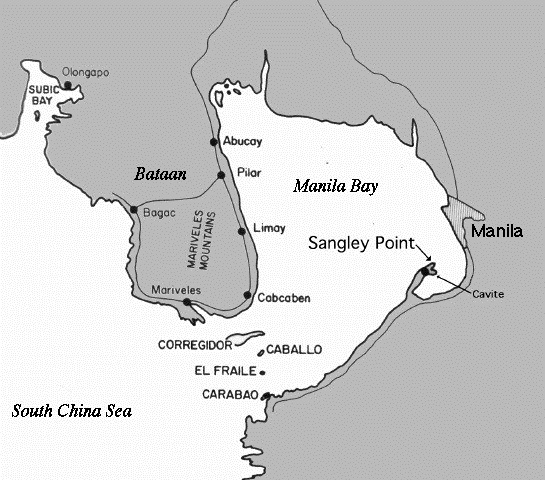 |
Above: Map of Luzon Island, showing the Philippine capital, Manila, Cavite naval base, Bataan Peninsula, and Corregidor Island, the last stronghold in the Philippines to fall to the Japanese invaders, May 6, 1942. The six-month campaign cost the Allies 140,000 lives.
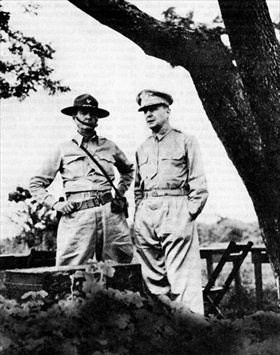 | 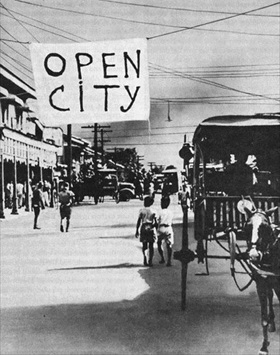 |
Left: Gen. Douglas MacArthur, commander of the United States Army Forces in the Far East, and, to his right, Maj. Gen. Jonathan M. Wainwright, October 10, 1941. The USAFFE comprised four tactical commands. Wainwright commanded the North Luzon Force, which defended both the most likely sites for Japanese amphibious attacks and the central plains of Luzon.
![]()
Right: On December 23, 1941, MacArthur ordered 130,000 U.S. and Filipino troops on Luzon Island to begin withdrawing to the Bataan Peninsula in an effort to avoid Japanese encirclement of Manila, which he declared an open city. All newspapers published the text of the proclamation and radio stations broadcast the news throughout the day. A huge banner bearing the words “Open City” and “No Shooting” was strung across the front of the city hall.
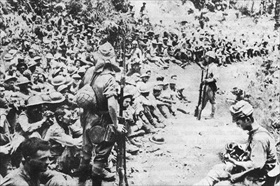 | 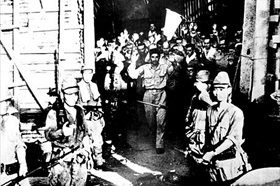 |
Left: U.S. and Filipino POWs after their surrender on Bataan Peninsula on April 9, 1942. The Japanese victory following the Battle of Bataan (January 7 to April 9, 1942) hastened the fall of the island bastion of Corregidor, 2 miles away, a month later. More than 60,000 Filipino and 15,000 American prisoners of war were forced into the infamous Bataan Death March.
![]()
Right: Surrender of U.S. forces at the Malinta Tunnel on Corregidor, May 6, 1942. The Battle of Corregidor (May 5–6, 1942) was the culmination of the Japanese campaign for the conquest of the Philippines. Corregidor, with its network of tunnels and formidable array of defensive armament, along with the fortifications across the entrance to Manila Bay, was the remaining obstacle to Lt. Gen. Masaharu Homma’s 14th Japanese Army. Corregidor and the neighboring islets denied the Japanese the use of Manila Bay, but the Japanese Army brought heavy artillery to the southern end of Bataan and proceeded to block Corregidor from any sources of food and fresh water. Japanese troops forced the surrender of the remaining American and Filipino forces on May 6, 1942, under the command of MacArthur’s man-on-the-spot in the Philippines, Lt. Gen. Jonathan Wainwright.
Japanese Conquest of Philippines, 1941–1942
![]()

 History buffs, there is good news! The Daily Chronicles of World War II is now available as an ebook for $4.99 on Amazon.com. Containing a year’s worth of dated entries from this website, the ebook brings the story of this tumultuous era to life in a compelling, authoritative, and succinct manner. Featuring inventive navigation aids, the ebook enables readers to instantly move forward or backward by month and date to different dated entries. Simple and elegant! Click
History buffs, there is good news! The Daily Chronicles of World War II is now available as an ebook for $4.99 on Amazon.com. Containing a year’s worth of dated entries from this website, the ebook brings the story of this tumultuous era to life in a compelling, authoritative, and succinct manner. Featuring inventive navigation aids, the ebook enables readers to instantly move forward or backward by month and date to different dated entries. Simple and elegant! Click 











